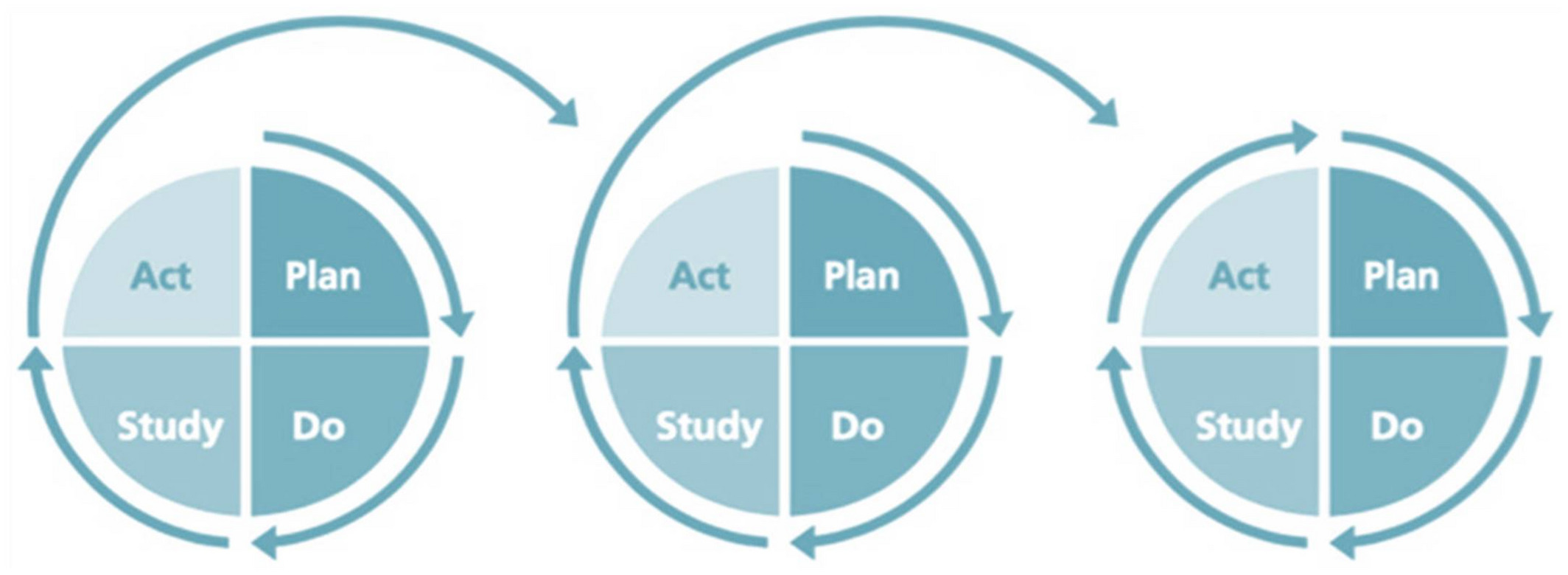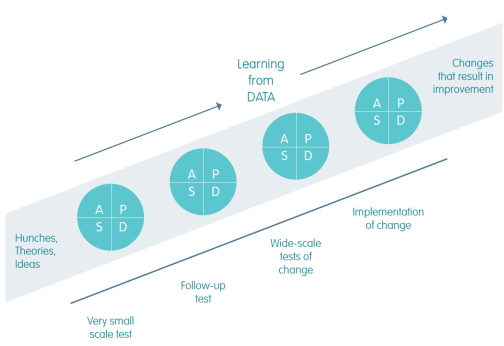PDSA
PDSA as the Scientific Method for Improvement
 Figure X-1. PDSA model for improvement | Diagram by American Cancer SocietyOpens in new window
Figure X-1. PDSA model for improvement | Diagram by American Cancer SocietyOpens in new window
Plan-Do-Study-Act (PDSA), sometimes referred to as Plan-Do-Check-Act (PDCA), is often known as the “Deming Cycle” or the “Shewhart Cycle,” after Dr. W. Edwards Deming and his teacher, Walter Shewhart. The word “Act” is sometimes replaced with the word “Adjust.” PDSA (or PDCA) is an iterative learning, improvement, and problem-solving model based on the scientific method. |
The PDSA steps are:
- Plan: Initiating a change by understanding the current situation and root cause of problems; developing a change and stating a hypothesis about what will occur with the change
- Do: Carrying out a small-scale test, or pilot, of the change
- Study: Testing the change and its hypothesis — gathering data, observing the changes and outcomes
- Act: Based on those results, deciding to accept, adopt, and spread the change, or making adjustments (or trying something different)
PDSA is an iterative model, so even a successful change leads us to a new starting point for continued improvement. Our process for spreading a change will include testing it in a larger area or in different conditions, learning from each successive cycle. This sequential or serial PDSA model is illustrated in Figure X-1.
 Figure X-2. Illustration of a sequential or serial PDSA Model | Diagram by West of England Academic Health Science NetworkOpens in new window
Figure X-2. Illustration of a sequential or serial PDSA Model | Diagram by West of England Academic Health Science NetworkOpens in new window |
If the Study phase shows that a change was not really an improvement, we need an environment where people are not punished for their attempts at KaizenOpens in new window. If we have fear and punishment, people will be afraid to suggest changes or they will become incredibly cautious, only proposing those things that are certain to work. Quoting Mike Rother’s book Toyota Kata, “The idea is to not stigmatize failures, but to learn from them.”
Failure is only the opportunity to begin again more intelligently.— Henry Ford
Even without the fear of punishment, some people are afraid that they will be embarrassed by trying something unsuccessfully. Instead of PDSA, we might observe the following dysfunctional cycles in an organization:
- P-D: Plan-Do — not studying to see if the change was really an improvement; just assuming things are better as the result of a change
- P-D-J-R: Plan-Do-Justify-Rationalize — Knowing, but not being willing to admit, that our change did not lead to improvement
It is sometimes said that Toyota is successful on a larger scale because they have a high tolerance for failure in small improvement initiatives. In the long run, using a failure as an opportunity to learn creates a stronger organization.
- Research data for this work have been adapted from the manual:
- Mark Graban, Joseph E. Swartz. Healthcare Kaizen: Engaging Front-Line Staff in Sustainable Continuous Improvement.

